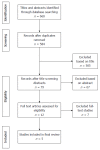Allocation of patients with liver cirrhosis and organ failure to intensive care: Systematic review and a proposal for clinical practice
- PMID: 26269687
- PMCID: PMC4528040
- DOI: 10.3748/wjg.v21.i29.8964
Allocation of patients with liver cirrhosis and organ failure to intensive care: Systematic review and a proposal for clinical practice
Abstract
Aim: To propose an allocation system of patients with liver cirrhosis to intensive care unit (ICU), and developed a decision tool for clinical practice.
Methods: A systematic review of the literature was performed in PubMed, MEDLINE and EMBASE databases. The search includes studies on hospitalized patients with cirrhosis and organ failure, or acute on chronic liver failure and/or intensive care therapy.
Results: The initial search identified 660 potentially relevant articles. Ultimately, five articles were selected; two cohort studies and three reviews were found eligible. The literature on this topic is scarce and no studies specifically address allocation of patients with liver cirrhosis to ICU. Throughout the literature, there is consensus that selection criteria for ICU admission should be developed and validated for this group of patients and multidisciplinary approach is mandatory. Based on current available data we developed an algorithm, to determine if a patient is candidate to intensive care if needed, based on three scoring systems: premorbid Child-Pugh Score, Model of End stage Liver Disease score and the liver specific Sequential Organ Failure Assessment score.
Conclusion: There are no established systems for allocation of patients with liver cirrhosis to the ICU and no evidence-based recommendations can be made.
Keywords: Allocation; Cirrhosis; Failure; Intensive care; Treatment.
Figures




References
-
- Shawcross DL, Austin MJ, Abeles RD, McPhail MJ, Yeoman AD, Taylor NJ, Portal AJ, Jamil K, Auzinger G, Sizer E, et al. The impact of organ dysfunction in cirrhosis: survival at a cost? J Hepatol. 2012;56:1054–1062. - PubMed
-
- McPhail MJ, Shawcross DL, Abeles RD, Chang A, Patel V, Lee GH, Abdulla M, Sizer E, Willars C, Auzinger G, et al. Increased Survival for Patients With Cirrhosis and Organ Failure in Liver Intensive Care and Validation of the Chronic Liver Failure-Sequential Organ Failure Scoring System. Clin Gastroenterol Hepatol. 2015;13:1353–1360.e8. - PubMed
-
- Dam Fialla A, Schaffalitzky de Muckadell OB, Touborg Lassen A. Incidence, etiology and mortality of cirrhosis: a population-based cohort study. Scand J Gastroenterol. 2012;47:702–709. - PubMed
-
- Ruiz-del-Arbol L, Monescillo A, Arocena C, Valer P, Ginès P, Moreira V, Milicua JM, Jiménez W, Arroyo V. Circulatory function and hepatorenal syndrome in cirrhosis. Hepatology. 2005;42:439–447. - PubMed
-
- Jalan R, Saliba F, Pavesi M, Amoros A, Moreau R, Ginès P, Levesque E, Durand F, Angeli P, Caraceni P, et al. Development and validation of a prognostic score to predict mortality in patients with acute-on-chronic liver failure. J Hepatol. 2014;61:1038–1047. - PubMed
Publication types
MeSH terms
LinkOut - more resources
Full Text Sources
Other Literature Sources
Medical

